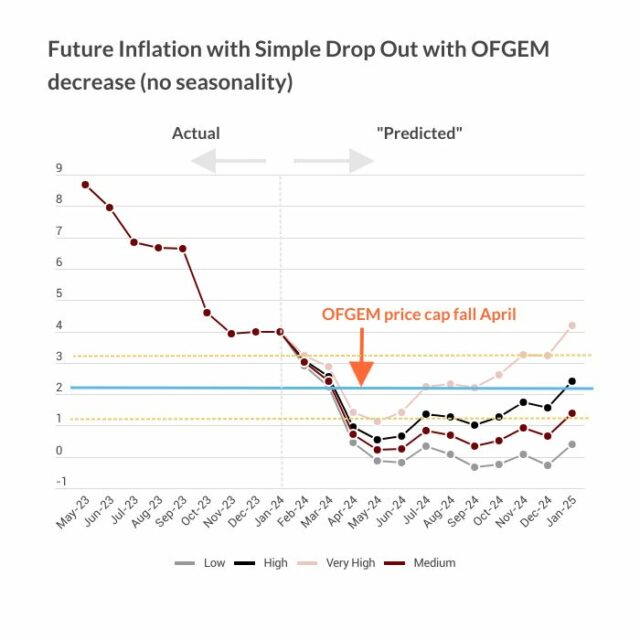What is the Current State of the UK Economy?
Ahead of the upcoming Budget on 6 March, our Deputy Director for Macroeconomic Modelling and Forecasting, Stephen Millard, spoke to NIESR Economist Paula Bejarano Carbo to get her take on the current state of the UK economy.
 Post Date
Post Date
 Reading Time
Reading Time

On 13 February, the ONS released data relating to the labour market, including data from the Labour Force Survey for the first time since October of last year. What does this data tell us about the current state of the UK labour market?
I would like to highlight three points from these data: 1) average earnings grew at a slower pace at the end of 2023 relative to the very high annual growth rates observed earlier in the year, but earnings growth remains high by historical standards; 2) workers have only started to see their earnings grow in inflation-adjusted terms since this summer, following around two years of real wage erosion; and 3) the increase in people not participating in the labour force because they are long-term sick remains a serious challenge for policymakers.
The annual growth rate of average weekly earnings in the last quarter of 2023, relative to the previous quarter, was 6.2 per cent (excluding bonuses). This rate has been on a decreasing trend since peaking at 7.9 per cent in August 2023. That said, it remains well above its post-2001 average of 3.2 per cent.
Earnings which are adjusted to reflect the current rate of inflation are called ‘real earnings’ – this term can help us capture the fact that if wages fail to match price rises, households are materially worse off. When we adjust for inflation, the annual growth rate of average weekly earnings, including bonuses, falls from 5.8 per cent to 1.4 per cent in Q4, indicating the extent to which inflation continues to erode workers’ real incomes.
Most workers saw their real incomes contract throughout 2022 and into 2023, until high wage growth in summer 2023 (including one-off payments, such as civil service bonus payments) pushed the annual growth rates of real total average weekly earnings into positive territory. We can think of high wage growth in 2023 and the expected high wage growth in 2024 as necessary for workers’ real wages to ‘catch-up’ to where they might have been prior to the cost-of-living crisis.
As you said, the ONS have not released updates from their Labour Force Survey since October 2023, due to certain issues surrounding LFS data, described in NIESR’s latest Wage Tracker. The LFS gathers information from households to construct key labour market measures such as employment, unemployment, and economic inactivity (used to describe people that are not part of the labour force because they are not in employment and are not currently looking for work).
Most importantly, the newly updated LFS data tell us that the number of people economically inactive increased significantly in 2023. This partially reflects updates to estimates of the UK population: for example, in the latest population estimates, there are more people aged 16-24 and more women than previously thought, which are two groups that tend to have higher rates of economic inactivity. However, when we look at data which breaks down economic inactivity by reason, we can see that the main driver of recent increases in inactivity has been an increase in people reporting that they are long-term sick. Addressing this challenge requires targeted interventions by policymakers, such as reducing NHS waiting lists.
You mentioned inflation earlier, what did we learn from the inflation numbers released on 14 February?
The 14 February ONS data release indicates that annual Consumer Price Index (CPI) inflation was 4.0 per cent in January, unchanged from December. This means that the average prices in an average household’s spending ‘basket’ in January 2024 were 4.0 per cent higher than those in January 2023.
The January data represent a downward surprise in CPI inflation, given that NIESR’s most recent UK Economic Outlook had forecast a rise in CPI inflation in January relative to December. As described in the Outlook, we project that CPI inflation will continue to fall throughout the rest of the first half of 2024 as energy prices continue to contribute negatively to inflation. So, this recent downward surprise may signal that inflation is set to fall even faster in the coming months than we projected. If true, the Bank of England’s Monetary Policy Committee may start to cut interest rates (currently standing at 5.25 per cent) in the spring.
However, the data also suggest that there are certain risks that might imply higher than expected inflation in the coming months (also known as ‘upside risks’). For example, inflation in services has averaged around six to seven per cent since the second half of 2022, and this figure rose slightly from 6.4 per cent in December to 6.5 per cent in January. This is relevant because services inflation mostly reflects domestic price pressures (in particular, wages in the services sector) rather than external factors (like energy or food import prices). So, services inflation can inform us about underlying domestic price pressures. That it remains so high indicates that underlying domestic inflationary pressures are an important upside risk to CPI inflation.
In our recent UK Economic Outlook, we noted that the MPC will not want to lower interest rates prematurely and have to raise them again. So, while the recent inflation data signal that inflation may fall faster than expected in 2024 and that we might see interest rates fall soon, we think some caution will be exercised by the MPC in this respect.
Finally, much has been made in the media of the fact the UK was in recession in the second half of 2023. What’s your take on the GDP numbers that came out on 15 February?
My view is that the most important takeaway from the 15 February ONS data on gross domestic product (GDP) is that the economy has not grown since 2022.
Turning to the detail, monthly GDP fell by 0.1 per cent in December, following growth of 0.2 per cent in November. This monthly figure was mainly driven by decreasing output in the services sectors, particularly in the wholesale and retail trade category, as well as the construction sector.
Looking at the broader picture, GDP contracted by 0.3 per cent in the fourth quarter of 2023 relative to the previous three-month period. This was generated by contractions in all main sectors: services output fell by 0.2 per cent, production output fell by 1.0 per cent and construction output fell by 1.3 per cent.
The Q4 data marks two quarterly consecutive falls in GDP, following a fall in GDP by 0.1 per cent in Q3. By the standard metric, this means that the UK economy was in a shallow recession in the second half of last year. However, as argued in NIESR’s GDP Tracker, whether the economy was in a ‘technical recession’ (two consecutive quarters of negative growth) in 2023 is largely beside the point.
The ‘technical recession’ metric is both arbitrary and not greatly informative. The state of UK economic growth is better described by the fact that GDP growth has been near zero since early 2022. In fact, GDP fell between the first quarter of 2022 and the final quarter of 2023. Further, GDP per head remains lower than pre-Covid – meaning one measure of our living standards is worse now than it was pre-pandemic. This should be of more concern than whether growth in the last two quarters was just below zero.
To be more positive, in our recent UK Economic Outlook, we projected that GDP will grow by 0.9 per cent in 2024. This outlook for economic growth is quite low by historical standards, and we expect it to remain around the 0.9 per cent figure for the next few years, unless certain policies are implemented to boost growth, such as increased public investment. Still, low growth is still growth, and better than a sustained flatlining of the economy.
So how about you sum all of this up for me?
Taken together, last week’s data tell us a fair bit about the current state of the UK economy.
The good news is that workers are finally seeing their real incomes grow; CPI inflation is on a downward trend and likely to fall to, or below, the Bank of England’s two per cent target in the coming months; and the economy will probably grow somewhat in 2024.
That said, many challenges remain to be addressed by policymakers. In particular: targeted interventions are needed to reduce long-term sickness in the UK; upside risks to inflation may require the MPC to exercise caution in cutting interest rates, which might have adverse effects on interest-sensitive sectors and mortgagors; and large reforms, such as an increase in public investment, will be needed to escape the current low-growth trend that threatens to lower UK living standards even further.






















